Cannabis Plants Anatomy: From Seeds To Buds

- 1. Anatomy of female vs male plants
- 2. Seeds and seedlings
- 3. Roots
- 4. Fan leaves
- 5. Sugar leaves
- 6. Pre-sex structures
- 7. Branches and stems
- 8. Nodes
- 9. Flowers (buds)
- 10. Pistils and stigmas
- 11. Bracts
- 12. Trichomes
- 13. The life cycle of cannabis plants
- 13. a. The germination stage
- 13. b. The seedling stage
- 13. c. The vegetative stage
- 13. d. The flowering stage
- 14. The difference between autoflowering and photoperiodic plants
- 15. In conclusion
Many consumers have seen a cannabis flower (aka buds) and maybe leaf but have never seen a male or female plant grow from seed. When growing cannabis, it’s essential you become familiar with the anatomy of a male and female cannabis plant to know what they need and prevent problems. It's crucial you know the parts of a cannabis plant such as roots, nodes, calyxes, and trichomes in order to grow cannabis seeds and maintain a healthy garden.
1. Anatomy of female vs male plants
Cannabis plants are dioecious, this means they have separate sexes, so the cannabis plants can be male or female. In cannabis, the female plant produces high levels of cannabinoids and develops flowers (buds) while the male plant produces low levels and develops pollen sacs.
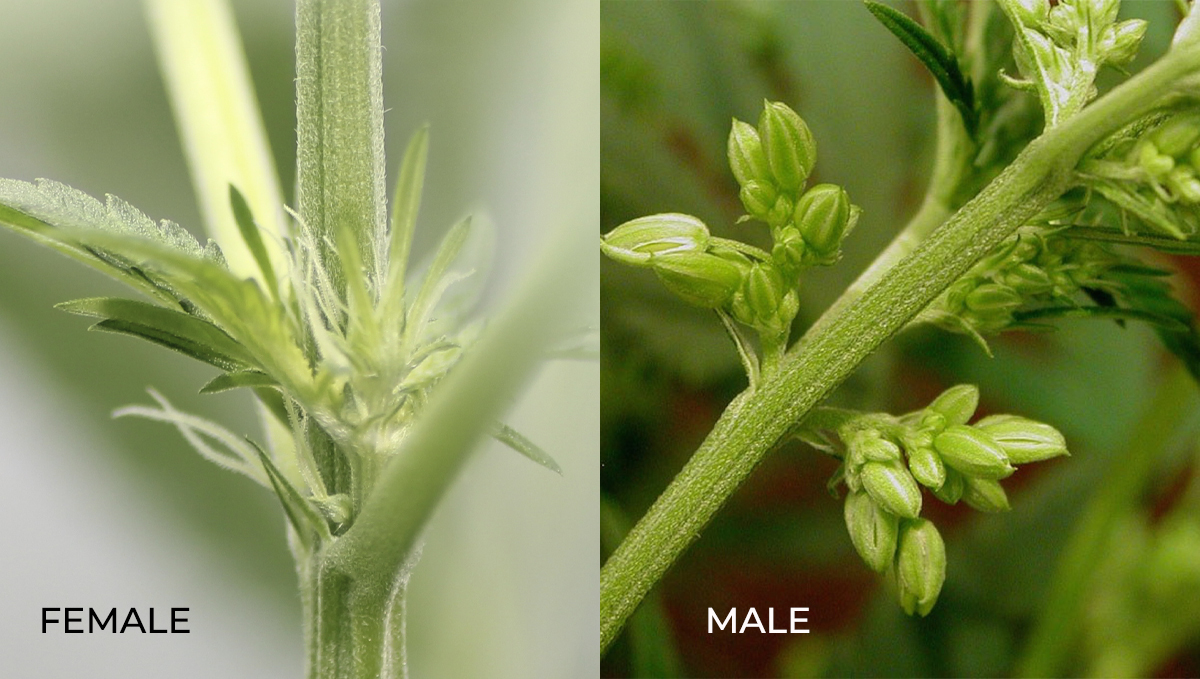
When both of them interact, the male pollen fertilizes female flowers (the buds), producing seeds that are used for breeding and cannabis cultivation. It’s essential you know which plant you need to grow to achieve the desired results, so in this article, we’ll explain the main differences and the anatomy of a cannabis plant.
Keep in mind that you may also find a hermaphrodite cannabis plant. A hermaphrodite cannabis plant will develop both male and female sexes, meaning you will see pollen sacs and white hairs on the same plant. Remember that a hermaphrodite cannabis plant is not a bad thing per se, but if you’re looking to grow buds and not make seeds then you should stay away from a hermaphrodite cannabis plant.
2. Seeds and seedlings
A seed is the first thing you need to start growing your own female cannabis plant, a cannabis seed has a hard shell to protect the embryo, this embryo is what will develop into a seedling when germinated, and eventually a full-grown plant. When exposed to the right temperature and moisture, you will see a seedling (baby plant) start to develop, this seedling comes out of the medium with a small pair of green rounded leaves named cotyledons.
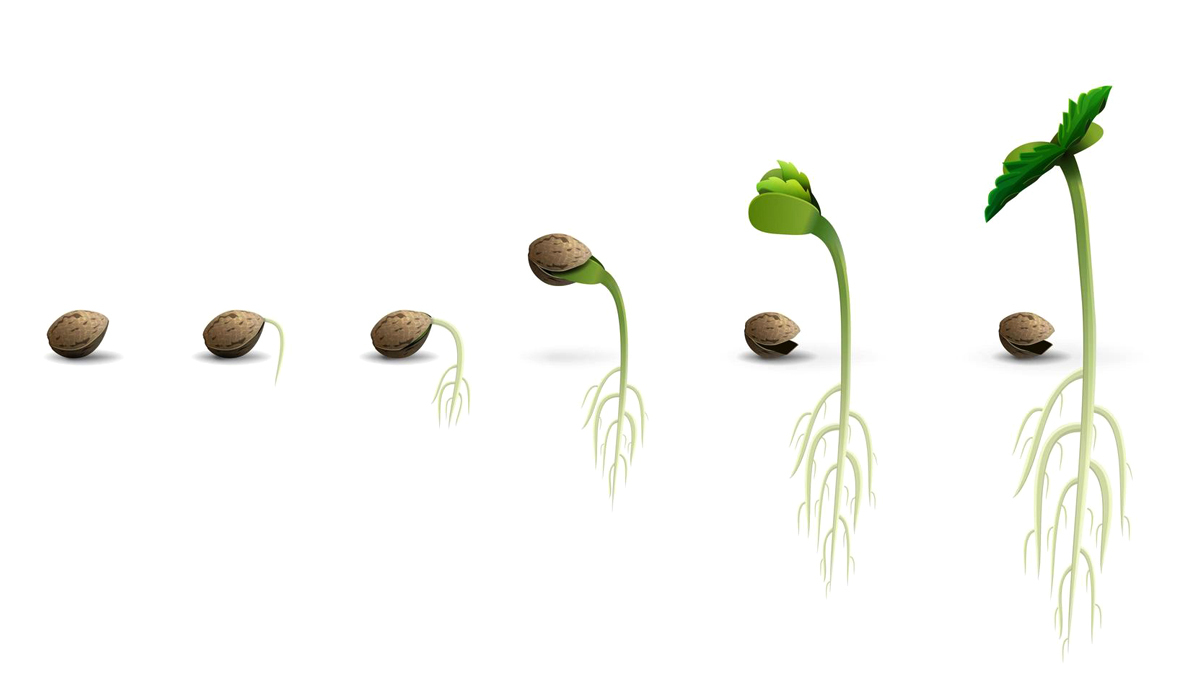
The cotyledons already contain chlorophyll which allows the tiny leaves to perform photosynthesis but it’s only in the early vegetative stage that you will see the first pair of serrated leaves develop and this is when the plant will start to absorb energy and nutrients, and direct it to the growth of foliage and stems.
3. Roots
After 3-5 days of exposing the seed to germination conditions, you will see a white “tail” coming out of the seed, this “tail” will start to grow longer and thicker as soon as the seed is planted and will eventually become your plant’s taproot, which is the main root from where rootlets sprout.
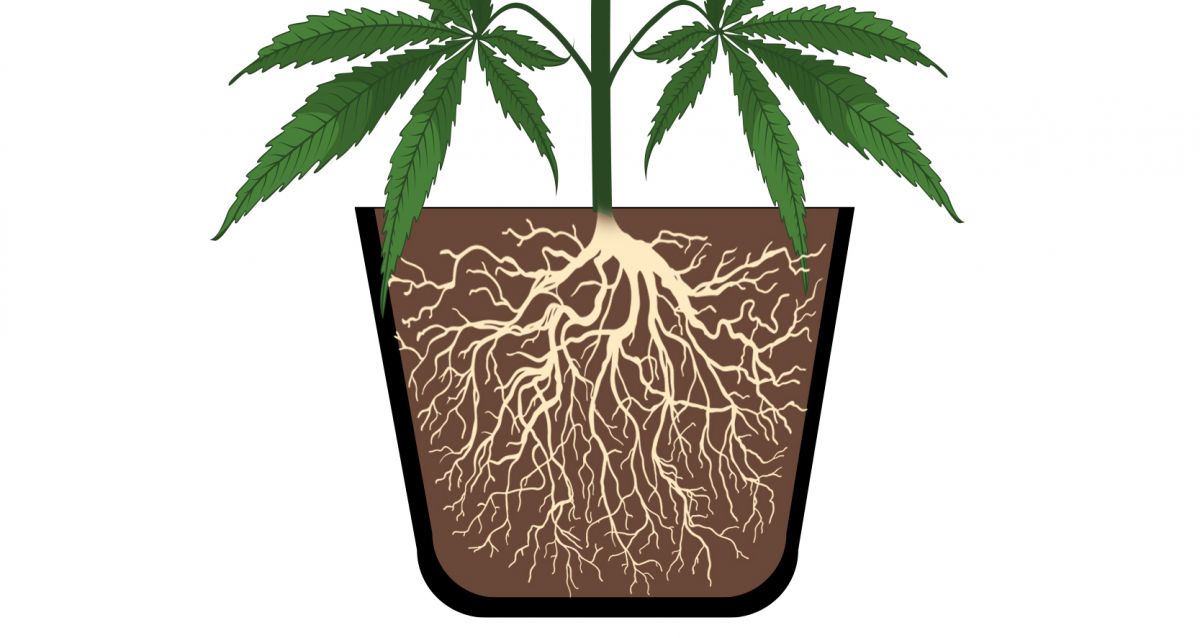
Once the taproot grows to a considerable size, several lateral roots will start to emerge from it, forming a network of roots in the soil, this root network is responsible for absorbing water and nutrients which are vital for your plant’s growth.
4. Fan leaves
After the cotyledons have appeared, they will be exposed to sunlight. This is important because the cotyledons use photosynthesis to absorb sunlight and produce energy for the plant to grow. After a couple of days, the first serrated leaves will appear, and as the plant grows, bigger foliage will appear and each time they will have more apexes, which are the fingers of a cannabis fan leaf.
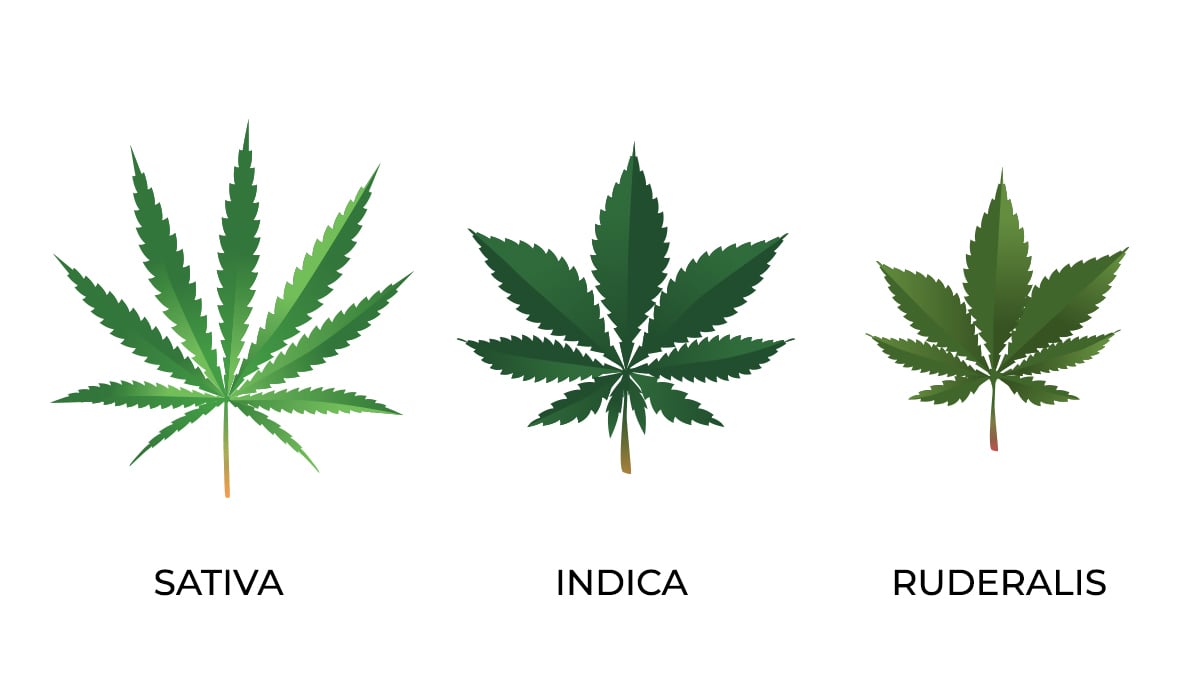
Depending on the genetics, the foliage can have five, seven, nine, or more fingers but either way, independent of the number of apexes, the fan leaves use sun, water, and C02 to produce the sugars needed for plant growth.
Also, the leaves are different depending on the genetics, for example, Indica leaves are usually wider with more fingers while Sativa leaves are thinners and have more fingers, there are also autoflowers that start with leaves similar to Ruderalis leaves and it can get complicated to differentiate so here’s a table to help you figure it out easier.
| Cannabis leaf characteristics |
|
|---|---|
| Species | Leaf characteristics |
| Sativa plant | Skinnier with up to 13 “fingers”. |
| Indica plant | Fat and wide leaves with up to 9 “fingers”. |
| Ruderalis plant | Short and compact, developing 3-5 “fingers. |
These sugars are a cannabis plant’s source of energy and it fuels growth and all the biological processes it needs. Have in mind that even though the foliage is a part of a cannabis plant, they have low levels of cannabinoids so their purpose is to absorb sunlight, store water, and also protect the buds from sunburn but are not usually smoked.
5. Sugar leaves
Sugar leaves are regular leaves but unlike fan leaves, they’re not too big and usually grow in between the buds on female plants. This foliage can sometimes have trichomes on them but will depend on the trichome production of each specific strain.
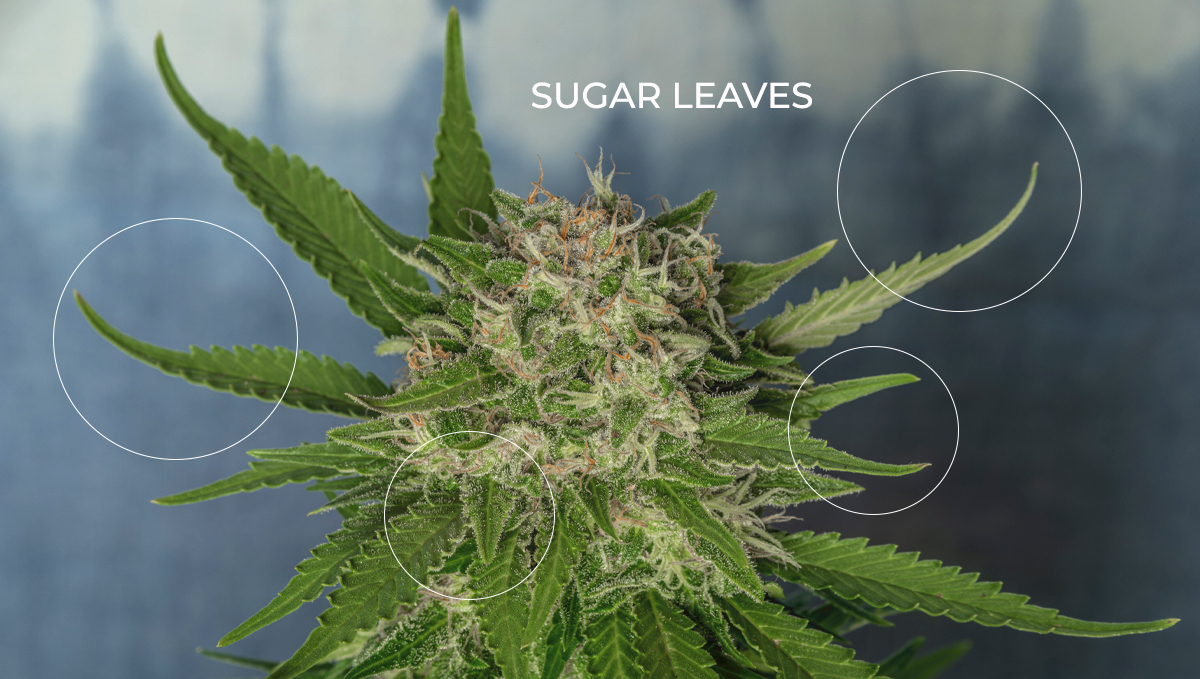
These leaves contain less resin than buds and are usually not consumed but depending on the quality of the genetics, these leaves can be used to make edibles, oils, and extracts.
6. Pre-sex structures
The pre-sex structures (which will eventually be the plants’ sex organs) appear on the internodes in the pre-flowering stage of the cannabis plant, if your plant turns out to be a male, you’ll see small balls appearing which are pollen sacs in the early stages and will grow buds.
These pollen sacs will eventually develop and open up, releasing the pollen needed to produce seeds, now, if you see white hairs (stigmas) instead of pollen sacs, your plant is definitely a female.
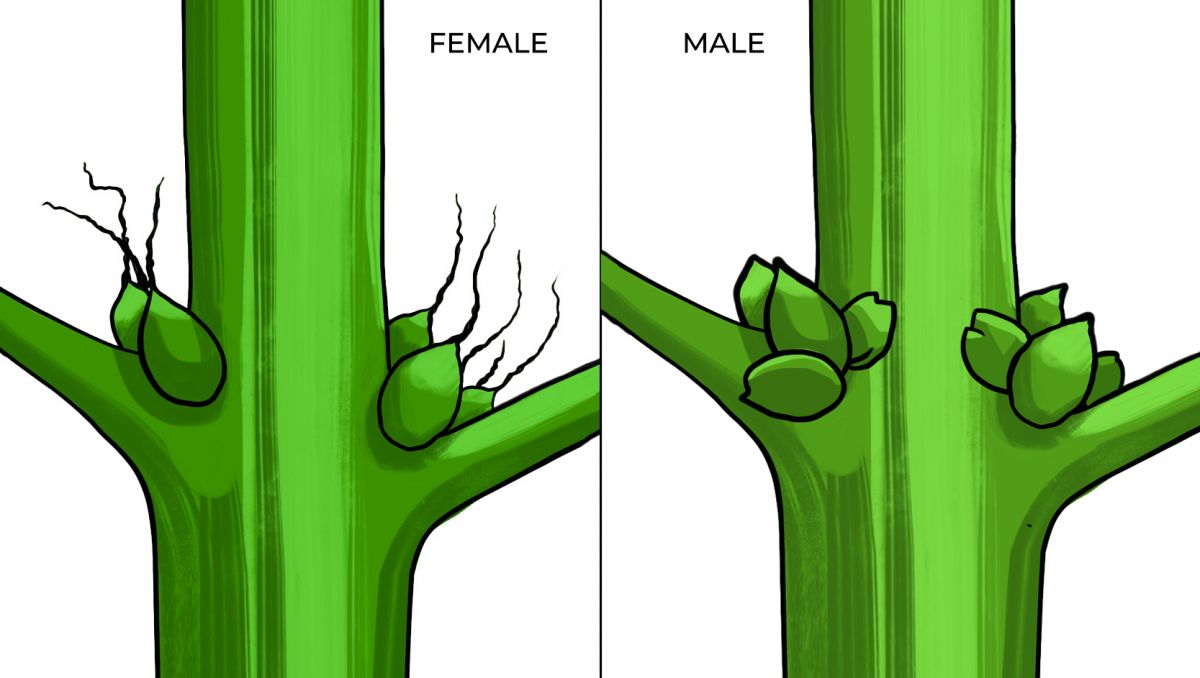
If you’re a home grower, you should “sex” your plants (grow a clone under 12/12 to see their sex organs) before they are completely mature, this will prevent the male plants from pollinating the female plants, have in mind that fertilized flowers will produce seeds which decreases the amount of cannabinoids and overall yield of the plant.
Now, if you’re a breeder or just want to experiment with cannabis breeding, you can have a breeding chamber so you can pollinate your plants in a controlled space and prevent cross-pollination because pollen is extremely light and can travel on your hair, clothes, and even by the wind.
7. Branches and stems
As said above, leaves absorb sunlight, and as new leaf growth appears, your plant will consequently get more light and the stem and branches will get thicker and thicker, developing more internodes (and more internodal spacing) on both sides of the stem.
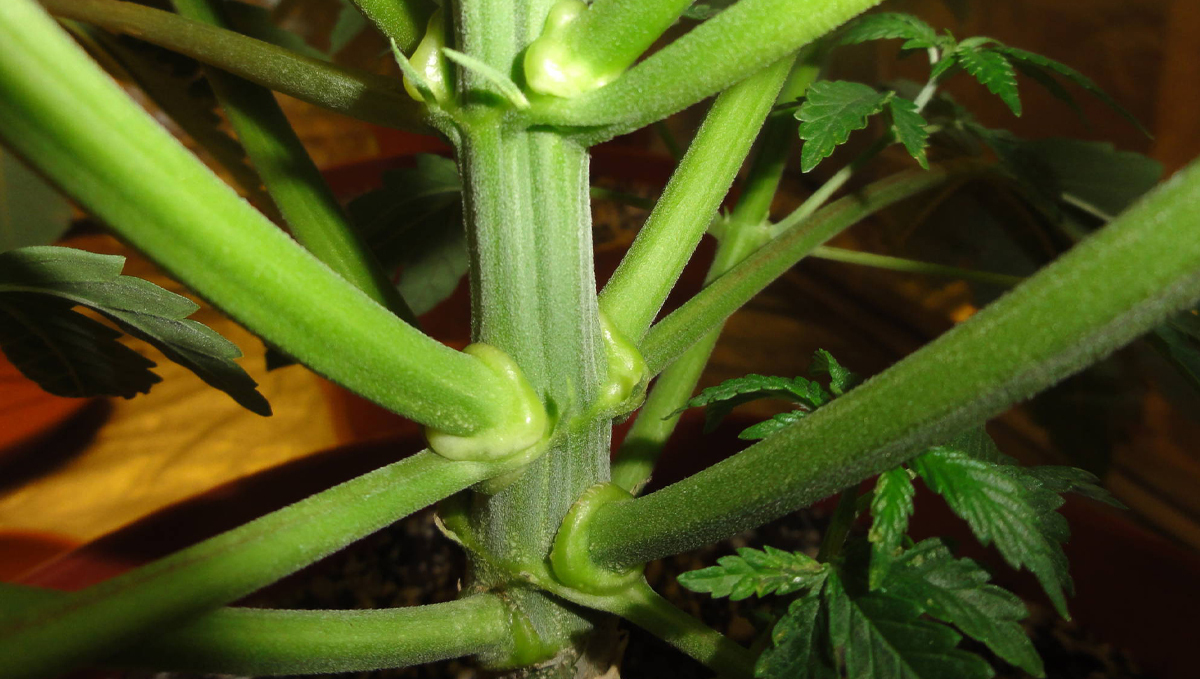
The main part of a cannabis plant’s anatomy is the stem, the stem provides support to the foliage, branches, and female or male flowers aka sex organs (basically the whole plant), inside the stem, there is a vascular system that consists of the Xylem and Phloem. The Xylem transports water and the nutrients dissolved in water while the Phloem is responsible for transporting sugars, proteins, and other organic molecules in plants.
Sometimes plants can develop mutations, these mutations are genetic mutations so they cannot be fixed, and although some mutations can result in odd growth such as irregular branching and leaf growth, they can still produce good quality flowers (buds), despite sometimes the yields being affected.
8. Nodes
Nodes are the point where branches come off from the stem, in the vegetative stage of a cannabis plant they’re parallel to each other but when your plant begins flowering the appearance of nodes can become irregular, now this isn’t a problem at all, it’s just a characteristic of some cannabis strain and is usually a trait that can help you identify a certain plant’s species.
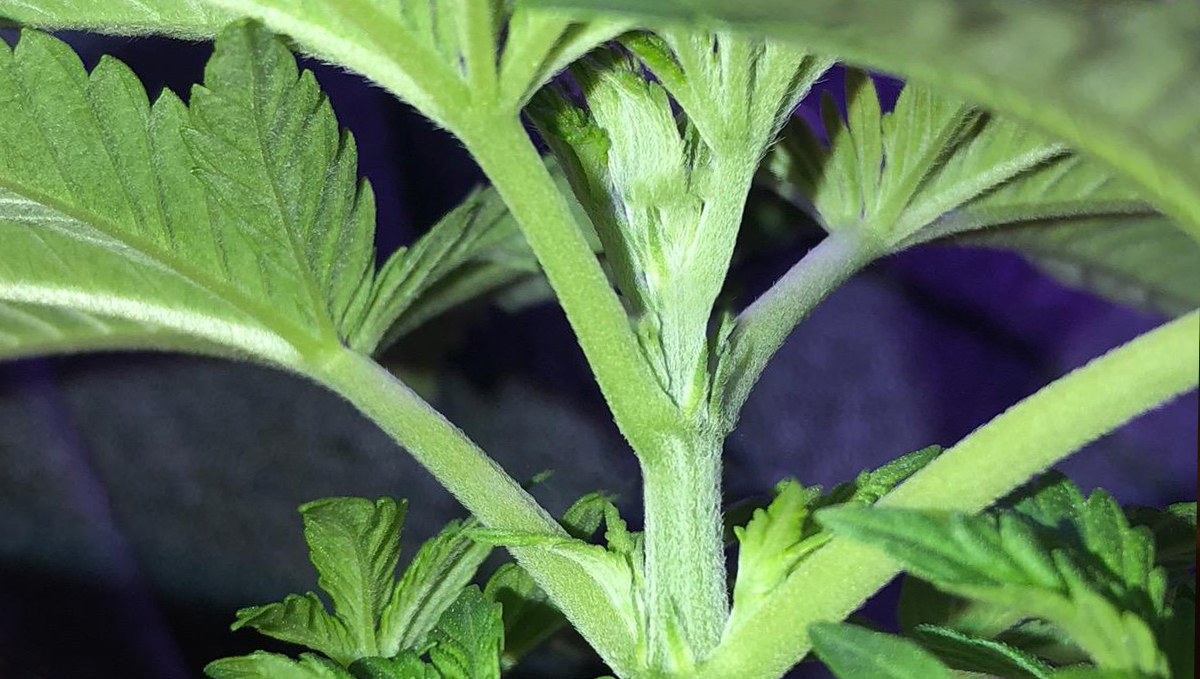
Have in mind that nowadays most cannabis strains are hybrids (a combination of Indica and Sativa genetics) so this won’t always be 100% correct but usually, Indicas tend to have nodes that are closer together while Sativa’s nodes are usually more spaced out.
These nodes are essential because they are where the buds or pollen sacs will start to develop and it’s where the first signs of your plant’s sex appear.
9. Flowers (buds)
The buds (flowers) are the most important part for growers but also for the cannabis plant, the flowers play several roles such as attracting pollinators and producing seed (once they’re fertilized) to perpetuate the plant species. Nowadays you can find feminized seeds which means the seeds will result in 100% female plants but in nature, cannabis plants are dioecious which means the plants will be male or female, as said before.
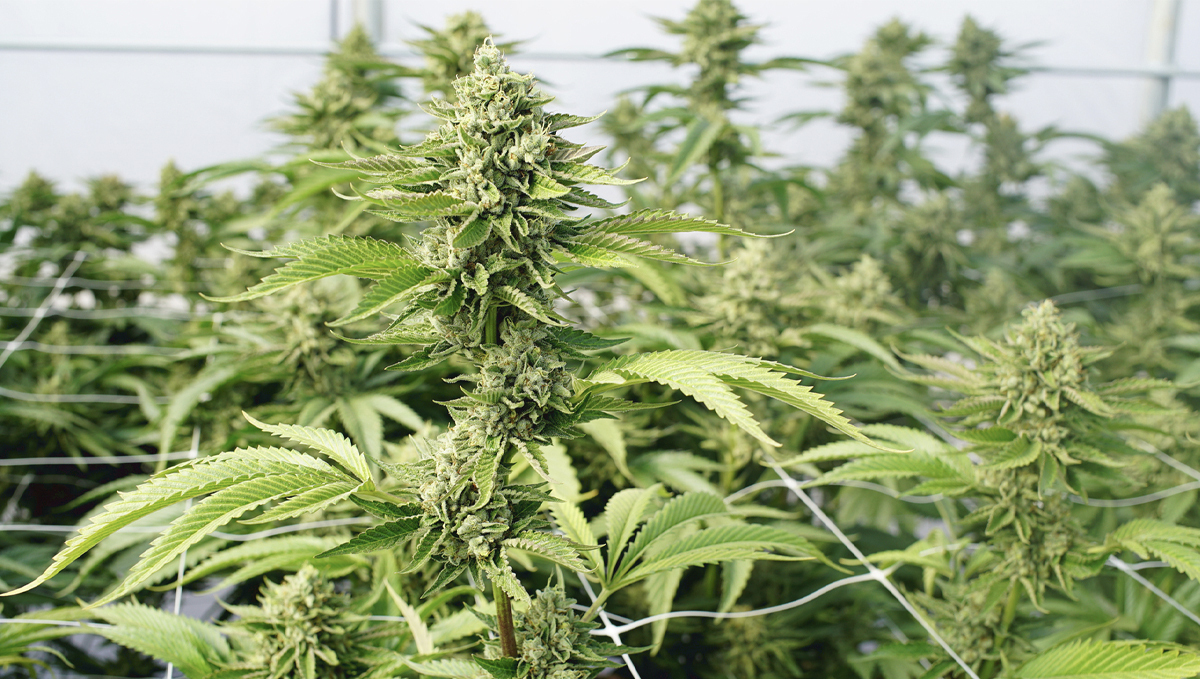
The pre-flowering stage is vital in differentiating whether the plant is a male or a female because it’s when a plant will show the first signs of its sex. The flowers (or buds) that form on the top of the stem are known as the cola, typically, a plant has one main cola but growers have come up with several methods of creating multiple main colas with plant training techniques (such as LST and HST) that help increase yields.
The main cola is known as the apical bud or main cola and it’s where most of the buds gather together to form the main bud, you’ll also see small clusters of flowers between the foliage in the internodes but, compared to the main cola, the side colas are smaller so this is why growers use both LST and HST.
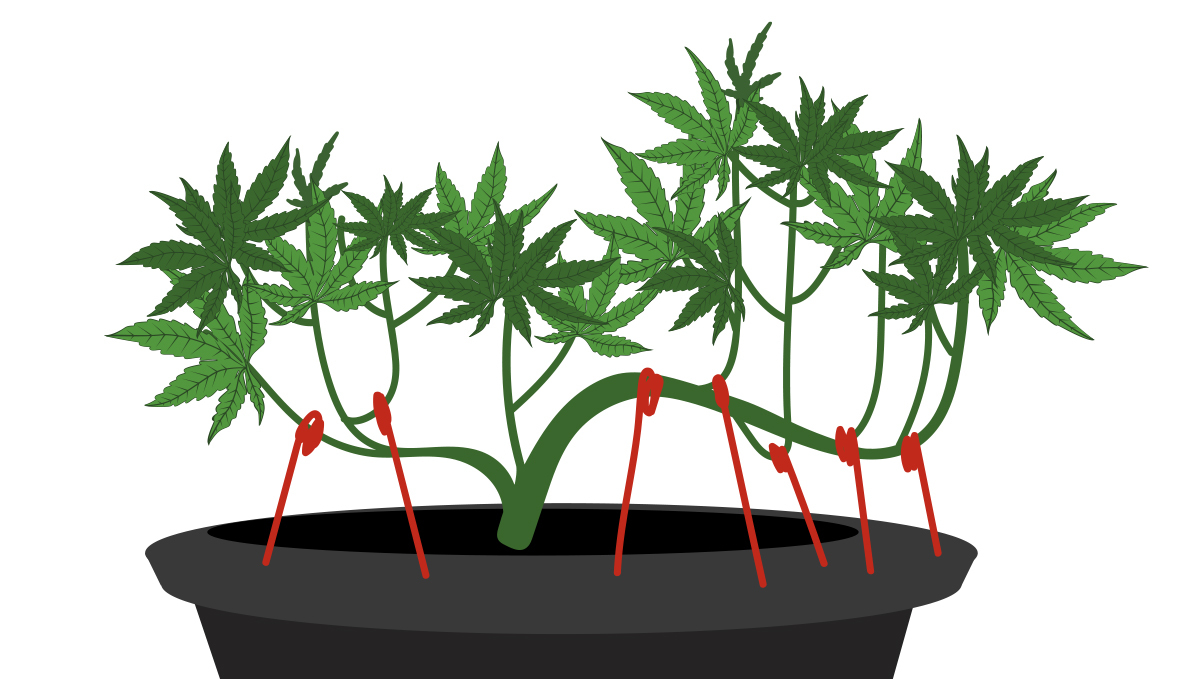
These two plant training methods end up changing the structure of the plant by exposing the flowering sites to more light and airflow, allowing the buds to grow bigger while also improving their quality.
When talking about flowers, there’s a distinction between female and male flowers. Male plants usually develop 2-3 weeks earlier than female flowers and, as said above, do not develop buds but they also form colas that consist of pollen sac clusters.
10. Pistils and stigmas
The pistils and stigmas are the reproductive parts of the female flowers, most cannabis consumers know the stigmas as pistils but that is wrong because the pistils are the part where the stigmas (white hairs) grow from. These hair-like parts are responsible for collecting pollen grains from the male flowers and consequently, produce seeds.
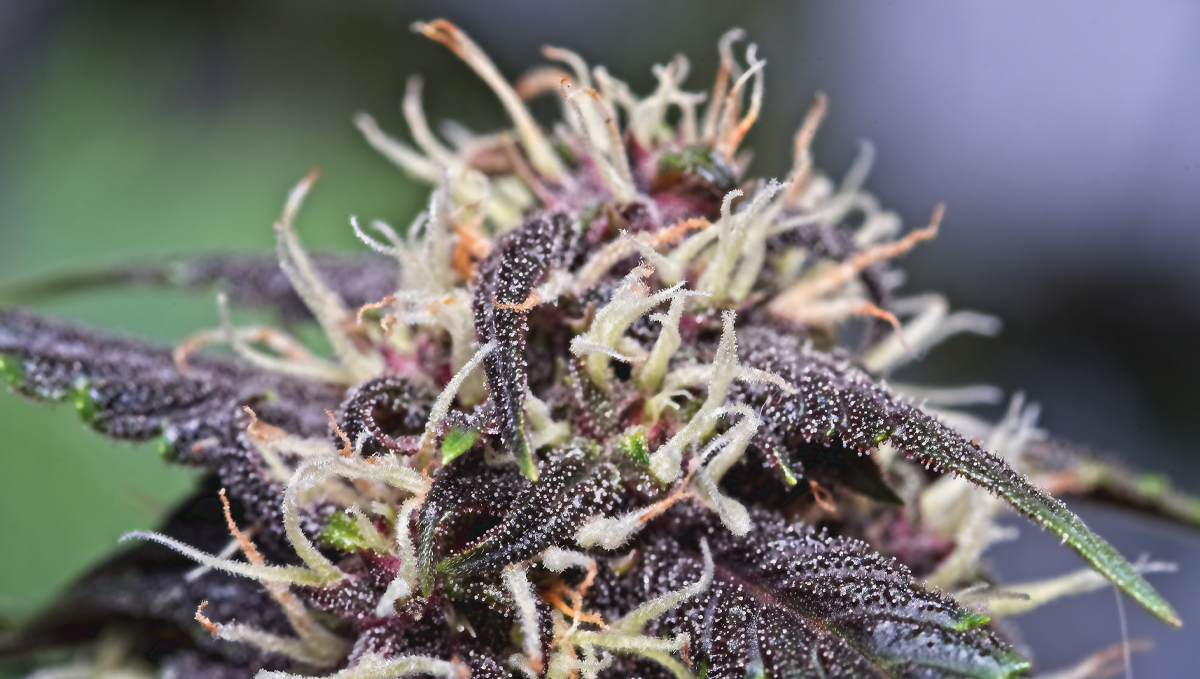
When a cannabis plant is fully mature, the stigmas can change color several times, usually starting with white hues, then yellow, orange, or red, and lastly, brown. Now, have in mind that the stigmas do not affect the potency or taste because they do not store any cannabinoids and don’t have trichomes so they won’t influence the quality and effect of your buds.
11. Bracts
The bracts, which are usually called calyxes by mistake, are what actually form the buds on a cannabis plant, they are pear-shaped nodules that develop between the sugar leaves but depending on the strain, they can appear in several colors, shapes, and sizes.
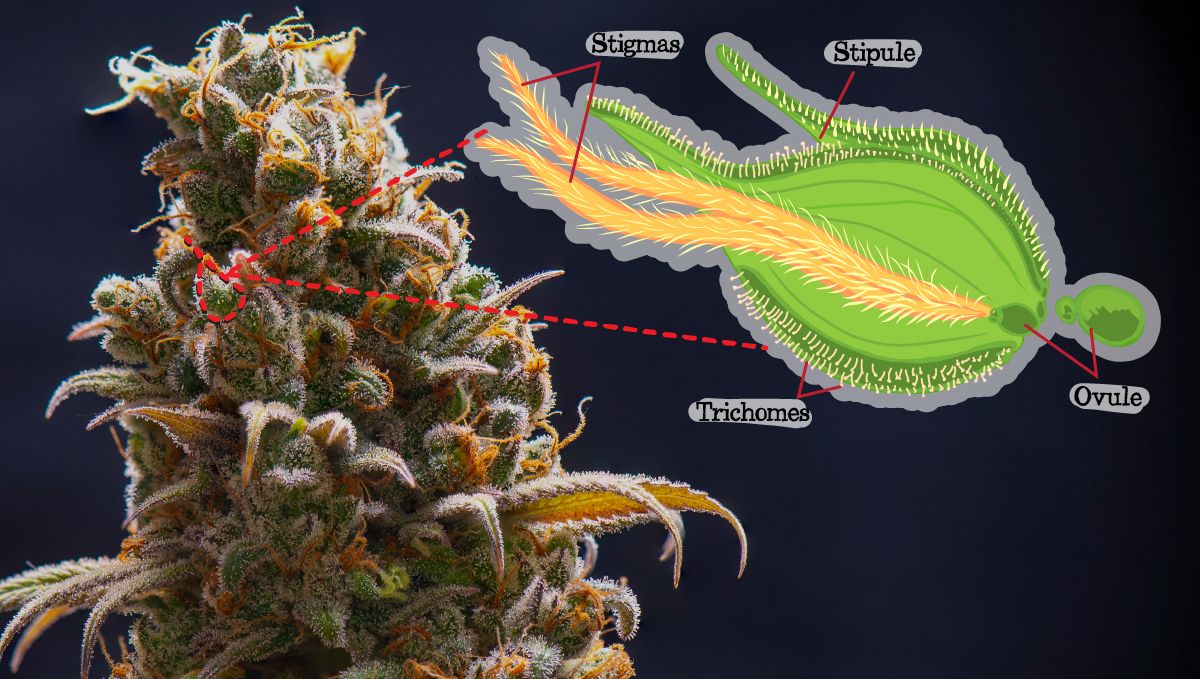
When the stigmas get pollinated, the bracts essentially turn into an ovary (seed incubator) which allows the seeds to grow and ripen but ends up affecting the yields and can affect the resin quantity on your buds, that’s why “sinsemilla” or feminized seeds are preferred by growers and consumers.
A non-pollinated flower is usually trichome-rich because your harvest will have more trichomes and they are responsible for producing and storing terpenes and cannabinoids.
12. Trichomes
Trichomes are the tiny crystals found all over the buds and surrounding foliage and are considered the most important part for cannabis consumers, these mushroom-shaped glands are clear and sticky, and form a thick layer on the buds. These mushroom-shaped glands known as trichomes can be found in different types and sizes, they are:
- Capitate-stalked trichomes 100 µm;
- Cystholitic trichomes 50 µm.
- Unicellular non-glandular trichomes 20 µm;
- Capitate sessile trichomes 20 µm;
- Complex bulbous trichomes 10 µm and;
- Simple bulbous trichomes 10 µm;
All “recreational strains” are THC-rich, depending on the strain, the trichome production may differ, resulting in more or fewer trichomes on your plants, but either way, all cannabis plants will produce trichomes.
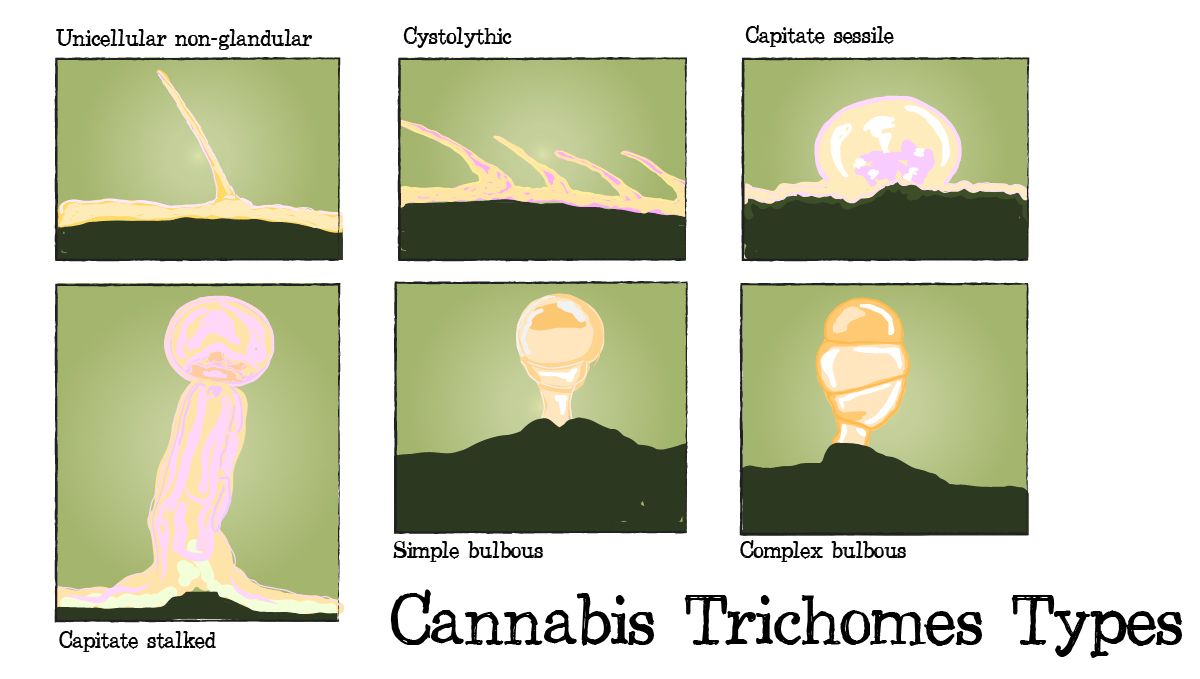
For home growers, the trichomes are the standard practice to know exactly when to harvest but in nature, the compounds produce by the cannabis plant provide defense mechanisms, such as terpenes, which smell helps keep away predators. Also, the sticky trichomes protect the buds from insects and against UV light, and although we don’t usually think about this when growing indoors, all the parts of a cannabis plant have an important role when cannabis plants grow in nature.
13. The Life Cycle of Cannabis Plants
Now that you know everything you need about the anatomy of cannabis plants, let’s understand a bit more about the life cycle of cannabis plants. Cannabis plants can take anywhere from 8 to 32 weeks to grow and mature, and during this time it goes through four stages, they are:
- Germination stage;
- Seedling stage;
- Vegetative stage;
- Flowering stage.
And it’s essential for you to understand these stages to grow healthy plants as each stage requires different light spectrums, light cycles, nutrients, and growing conditions.
The Germination Stage
Just like with any other plant, cannabis plants start from seeds. Cannabis seeds are dormant until exposed to warmth and moisture. This means that if you are looking to germinate cannabis seeds or any other type of seed, you will have to hydrate it and place it in good condition.
After planted, seeds can take anywhere from 3 to 10 days to germinate and seeds contain enough food for 2-3 weeks, which means there's no need to water with a nutrient solution until the seedling has come out of the soil. Once the seedling comes out of the soil, you’ll see two small rounded leaves which are called cotyledons, and this is what marks the beginning of the seedling stage.
The Seedling Stage
The seedling stage of cannabis plants can take anywhere from 1- 3 weeks, and sometimes more depending on the strain and growing conditions. During the seedling stage, plants focus on developing roots and foliage, this means that the roots are still small and fragile so be careful to not overfeed or overwater them.
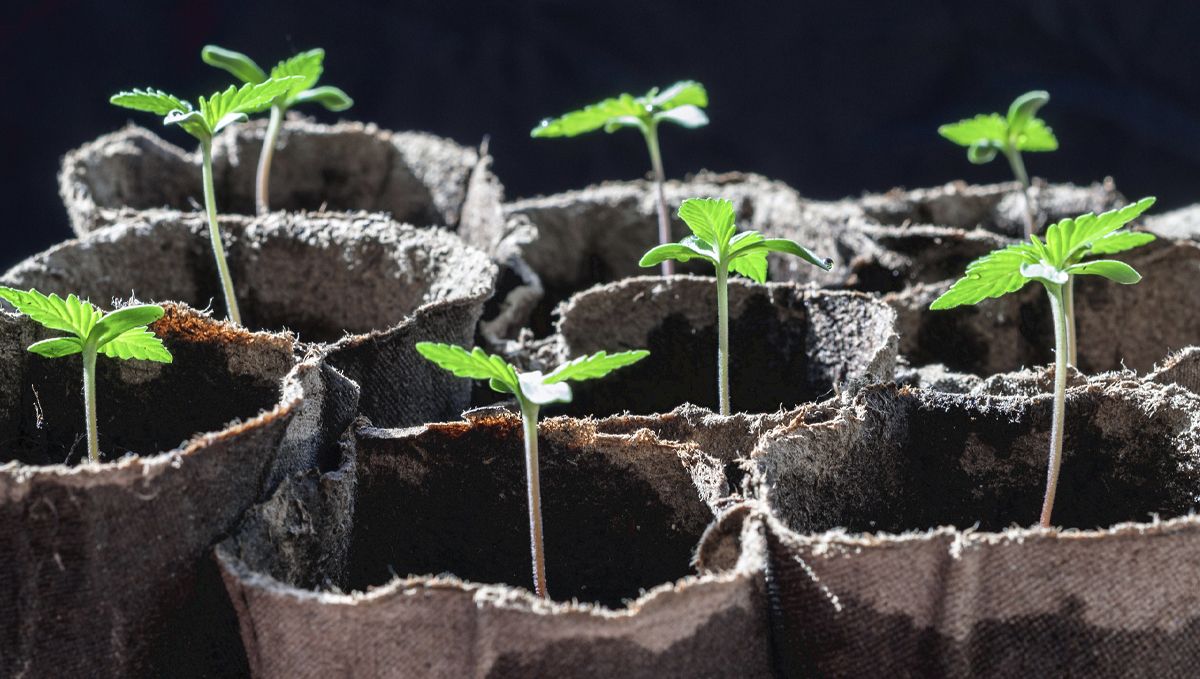
Once you’re in the seedling stage, make sure to provide 18 hours of light and 6 hours of darkness, and remember to keep an eye on them as they’re extremely susceptible to pests and diseases.
The Vegetative Stage
After a couple of weeks in the vegetative stage, your plants will start needing more food, light, and water as the roots and foliage start to grow exponentially. During the vegetative stage, you have to make sure you’re feeding your plant higher levels of nitrogen and less phosphorus and potassium as nitrogen is needed to develop foliage. If you’re growing indoors, the general rule is to flip to 12/12 (which triggers flowering) once the plant is ⅓ or ½ of the size you want them to be by harvest.
The Flowering Stage
Once you flip to 12/12 (or when autumn comes outdoors), your plants will start flowering. The flowering stage can take from 6 to 10 weeks or even more, depending on the strain. This stage starts with the appearance of pre-flowers which will eventually fatten up and turn into those delicious sticky flowers you've been waiting for so long. Obviously, this is just a quick rundown and there are a lot of things to keep in mind, other than the light cycle but understanding the life cycle and anatomy of cannabis plants will allow you to anticipate problems before they happen.
14. The Difference Between Autoflowering and Photoperiodic Plants
Alrighty then, there you go. Everything you need to know about the lifecycle of a cannabis plant. Or is it? What we have described above pertains to photoperiodic strains, but there's a new player in town. Autoflowers! Once thought of (quite rightly, to be fair) as the runt of the litter with smaller yield possibilities, and lower potency than their photoperiod cousins - Autoflowering strains can now stand proud and tall certain in the fact that they can mix it with the big girls.
Thanks to the hard work and dedication of a handful of select breeders over the past two decades or so, autos are now at the stage where they can match (and even outperform, in some cases) photo strains in all the important categories and have been for a few good years now. We are talking about the size of yields, the potency of the buds, and the terpene and flavonoid production.
And they come with some huge advantages over photo strains, for novice and experienced growers alike. These benefits include -
- Faster turnaround time - Some autoflowering plants can go from seed to harvest in around 8 weeks (with most strains taking less than 10 to 11 weeks - crazy fast), whereas photoperiodic strains can take at least twice as long, especially Sativa dominant cultivars.
- Easier to grow - Autoflowers require less attention and care than their counterparts. These are the sort of strains that can be planted and almost forgotten about.
- Versatility - Autos are incredibly versatile and can be grown in almost any environment and condition. They do not require a perfect climate like photoperiodic plants, and will often thrive in less-than-perfect conditions. This is thanks to their Ruderalis heritage, which hails from the harsh climate of northern Europe.
- Stealthiness - Autos are generally a little smaller and more compact than photoperiodic plants, making them easier to hide away.
- Hardiness - Autos, in general, have a higher resistance to pests, mold, and other diseases when compared to photoperiodic strains.
A higher number of harvests - Autoflowers can be harvested more than once a year because they do not rely on the seasons for their flowering cycle. This means that if you are growing outdoors, you can usually get two crops over and done within the same time as one photo crop. If you are an indoor grower, setting up a perpetual harvest routine (where you cycle plants through the room at different stages) is so much easier with autos, as plants in all stages of growth can be under the same lighting routine. we will get into this in more detail a little further down.
But how do autoflowering and photoperiodic strains differ in terms of the lifecycle?
Well, the main clue to the answer to this question is in the name. Unlike photoperiod cultivars, whose stage of growth is determined by the lighting period, autoflowering strains essentially have an inbuilt genetic timer that will switch from vegetative growth to flower production no matter what the lighting schedule is. This comes with a huge range of pros for both indoor and outdoor growers.
The best lighting schedule for autoflowers
So, we know that for photoperiodic strains to start the flowering cycle, we need to switch the lights from 18 hours on / 6 hours off per day to 12/12. Easy enough, but it does mean that you need dedicated vegetative and flower-growing areas if you are an indoor cultivator. This is not the case with autos! As we mentioned above, one of the main advantages of autoflowering plants is that they will flower no matter what the light schedule is, so long as they have enough light in total. This means you can keep autos under 24/0, 20/4, 18/6 lighting from seed to harvest. It's really up to you.
But, after years of experimentation and testing, we can confidently say that for the very best results with autos, we suggest running the lights either 20/4 or 18/6 per day. Autos will grow under a 24/0 schedule, but the lack of rest time can cause some stress issues depending on the strain. While this less important lighting schedule just makes life easier, it comes with another huge advantage...
Setting up a perpetual harvest routine with autoflowering strains
What's the one thing we all want as cultivators? Well, there are a few valid answers to this question, but the one we hear most often is - an unending supply of top-quality buds. And what's the easiest way to ensure your supply never runs dry? By setting up a perpetual harvest routine!
And while this can be done with photoperiod strain (through the use of separate veg and flower rooms), it's super simple when growing autos. Thanks to the fact that autoflowering strains will progress through the flowering stage no matter the lighting schedule, you can have all your plants in one single grow room. Simply stagger the start and finish times of your plants by planting new autos into the room every week or two (aim for around 3 - 4 weeks in the space). This way, you will have a continuous supply of buds being harvested and new plants being started. Perfect! The best way to do this is by splitting your grow are down the middle, with one side dedicated to plants in veg, and the other side dedicated to flower.
This way, when one of your autos on the flowering side is ready to be harvested, you can move it out and replace it with a new auto from the veg side. we also suggest running with a full ScrOG setup for the flowering plants, as this will keep the entire canopy at an even height throughout the flower stage - helping you achieve a balanced and uniform harvest. But what about yield? Does growing autos under a perpetual cycle reduce your overall harvest? The answer is no - provided you give each strain enough time to reach its full potential in terms of size and THC/CBD levels, you can expect to achieve the same yields from an auto-flower crop regardless of whether you are running a perpetual cycle or not. What about the seedlings?
Well, you can run them in the same room as the rest, but we don't suggest it. The main grow light is a little too intense for seedlings, and it's better to get them used to the conditions before plunging them into high-intensity lighting. Seedlings also like a slightly warmer and more humid environment than plants in full veg or flower growth. So, it's best to start your seeds in a warm room with softer light and temperatures between 22 - 28C (72-85F). Once they have formed a strong root system and are starting to display their first set of leaves, they can then be moved into the main grow room.
15. In conclusion
Cannabis plants are millennial plants that have developed and perfected their structure throughout the years, even though we don’t see it like that, all the parts of a cannabis plant (not only its sex organs) are essential for them to grow and perpetuate their species. Feel free to leave tips and more important information to help educate fellow growers, leave a comment in the comment section below!
External References:
- Morpho-Anatomy of Marijuana (Cannabis sativa L.). - Raman, Vijayasankar & Lata, Hemant & Chandra, Suman & Khan, Ikhlas & Elsohly, Mahmoud. (2017).
- Understanding Cannabis. - Hunt, Debra & Keefe, Joanne & Whitehead, Tammy & Littlefield, Amber. (2020).


















Comments